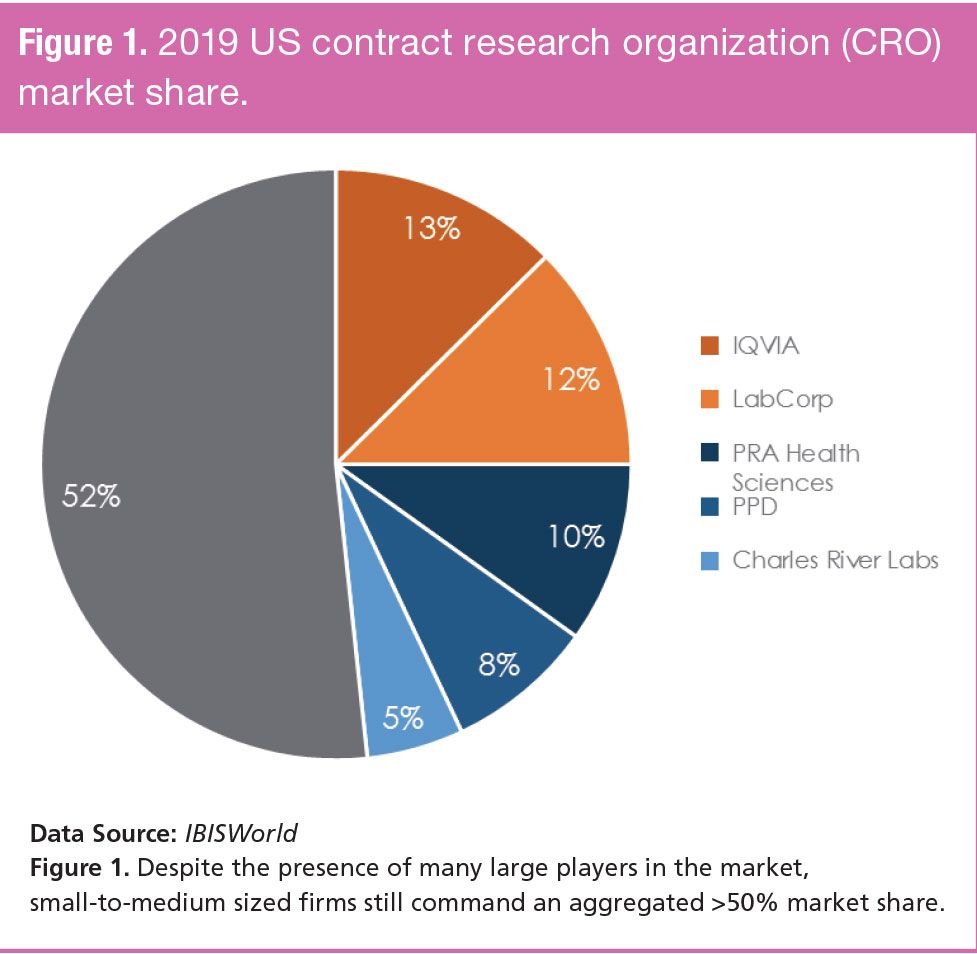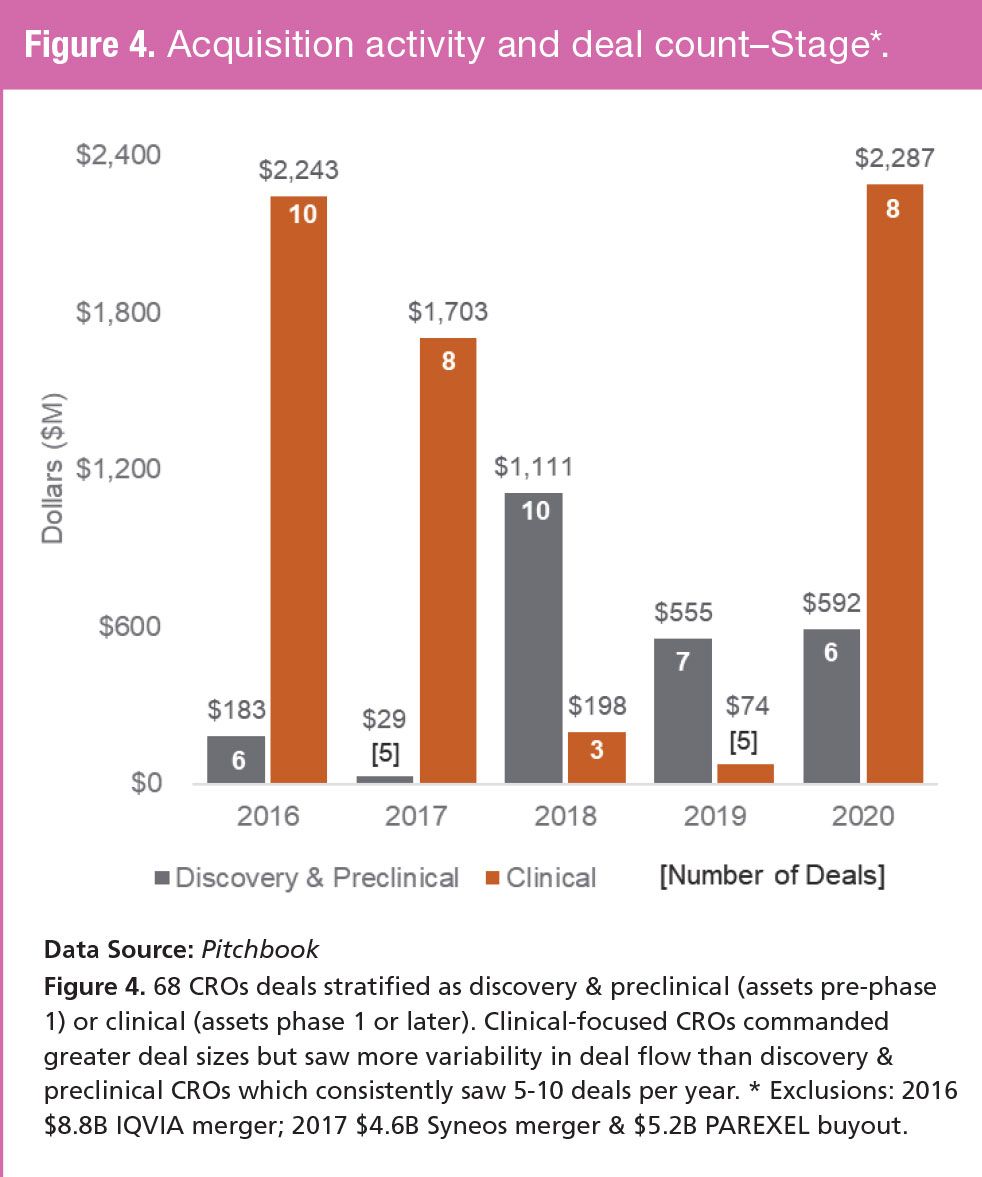Pharma Services Sector Poised for Continued Growth and Consolidation
The CRO market will see greater consolidation by both financial buyers looking to consolidate smaller players and larger CRO players wanting to expand into value-added specialty service areas.
ALPHASPIRIT - STOCK.ADOBE.COM

The COVID-19 pandemic has shined a light on the healthcare industry, particularly biopharmaceuticals, which has created strong tailwinds for the pharma services industry. As money continues to flow into the biopharma sector and industry players look to outsource more of its value chain, both contract research organizations (CROs) and contract development and manufacturing organizations (CDMOs) will continue to benefit. Additionally, the advent of personalized medicine and the development of complex gene therapies have led to greater specialization by smaller CROs, signaling a persistence in market fragmentation—a consistent theme seen over the past decade.
Outcome Capital, a Boston-based life sciences advisory and investment banking group, has been following the pharma services market dynamics for the past five years.The authors believe this fragmented market will give way to greater consolidation by both financial buyers looking to consolidate smaller players and larger CRO players wanting to expand into value-added specialty service areas. To secure future business, larger CROs will move toward long-term alliances with major pharmaceutical and biotech companies, which will put greater pressure on further market consolidation. Adding to this consolidation is a tepid fundraising environment, opening the door for financial buyers to play a more active role in consolidating many of the niche players. The increased presence of financial buyers will also likely lead to greater initial public offering (IPO) activity in the next three to five years, reversing a long industry trend.
Software and analytics will continue to have a greater influence in pharma services as more players look to leverage population data to help in enrollment and management of clinical trials. Acquires have already moved upstream to clinical trial management and analysis to complement traditional research and manufacturing capabilities. While the authors see the growth of the clinical segment outpacing that of preclinical services, highly specialized players with expertise across the development value chain offer a more well-rounded value proposition to potential clients, enabling them to lock in long-term alliances and capture more market share. However, with a surge of investigational new drug (IND) filings in 2020 (more than 3800 in 2020 vs. approximately 3600 from 2012–2019) (1), the discovery/preclinical segment will remain very active in the years to come.
Pharma services continue to see growth
Prior to COVID-19, investments in the biopharmaceuticals industry increased consistently year-over-year for the past five years on the heels of technological advancements and attractive returns for investors. The authors see a more robust investment landscape post-COVID as the pandemic has increased awareness of the healthcare sector. With more scrutiny on pharma R&D pipelines, the CRO and contract manufacturing organization (CMO) industry will continue to see growth. The clinical research segment will see a higher growth rate (8.1% 2018–2024 compound annual growth rate [CAGR]) (2), while the discovery and preclinical segment maintaining strong growth (7% 2018–2024 CAGR) (2) as biopharma players broaden their clinical pipelines.
The CRO market remains highly fragmented (Figure 1), with approximately 52% of the market captured by smaller or niche service providers.Large players such as IQVIA, LabCorp, PRA, PPD, and Charles River Labs will continue to command significant market share, but this fragmented market points toward consolidation from both the large strategic and financial buyers. The authors expect to see the trend of both vertical and horizontal expansion to persist for the foreseeable future. The majority of strategic acquisitions have been to capture specific niche or specialty services in a specific vertical.We have not seen any major CRO looking to move from the discovery/preclinical space to the clinical space or vice versa.
Figure 1. 2019 US contract research organization (CRO) market share. (Figures courtesy of the authors)

In 2020, the Outcome Capital’s CRO Index (see Figure 2), comprised of large, public CRO players, who often command market share due to size, scope, and scale, vastly outperformed the broader market as its performance was buoyed by COVID-19 testing, research, and therapeutic development. Interestingly, the public markets have rewarded different strategies over the past year.Charles River Labs (+65%) has been rewarded for its aggressive growth by acquisition strategy, while Medpace (+67%) has seen success by capturing the market share from smaller and medium-sized biopharma players.
Figure 2. CRO Index vs. Dow Jones–2020 performance.

Conversely, the smaller pharma services players still face intense competition in this fragmented industry, which will put downward pressure on valuation and may keep value suppressed without increased scale or scope.As larger players offer more diverse skillsets, smaller CROs will need to compete on more than just price.Increased specialization, faster turnaround times, and enhanced customer focus may continue to allow smaller CROs to capture customers, increasing their value and helping to improve the probability of a transaction.
A strong appetite for M&A and consolidation
Over the past five years, the number of M&A transactions has remained steady (see Figure 3); a few large mergers have skewed the total dollar value—2016 saw the $8.8 billion merger between Quintiles and IMS Health (now IQVIA), while 2017 saw the $4.6 billion merger of INC Research and InVentiv (now Syneos) and the $5B buyout of PAREXEL by Pamplona Capital.The wave of large transactions looks to be picking back up in 2021 as ICON announced its $12 billion acquisition of PRA Health Sciences, and Thermo Fisher announced their acquisition of pharma services giant PPD for $17.4 billion. An area of consolidation has been around software solutions and analytical technologies used in the pharma services space. ICON noted PRA’s mobile clinical trial management software as a primary catalyst for the acquisition, continuing the trend of technology acquisitions seen in 2019 and 2020.Both the IQVIA and Syneos mergers were driven by the need to deliver greater value through data and clinical trial analytics.Additionally, the largest deal by a financial buyer (Astorg’s $1.8 billion buyout of eResearch Technology) also focused on clinical analytics.
Figure 3. Acquisition activity–buyer type (2016–2020).

While clinical trial software and analytics will continue to drive value, traditional services companies still saw healthy activity over the past five years; however, both strategic and financial buyers sought to acquire CROs and CDMOs with differentiated offerings either through specialized indications or breadth of services. Curiously, CMOs have not been able to take advantage of advanced analytics or specialization, and as a result, their overall deal numbers and values have lagged. In the past five years, only 23 CMO acquisitions have taken place for a total of approximately $1.3 billion (compared to 25 deals totaling >$5.8 billion for CDMOs and 70 deals totaling >$21.8 billion for CROs).
Over the past five years, the number of CRO transactions remained relatively stable (see Figure 3), but the number of transactions seen in either the discovery/preclinical space or clinical space fluctuated widely from year-to-year, along with the deal values (see Figure 4).The overall difference between discovery/preclinical (31 transactions) and clinical (34 transactions) were even, despite each year having its own unique profile.Generally, the clinical segment draws larger transaction sizes, with >$18.3 billion in deal value (including 4 deals >$1 billion each) over the past five years.Companies with clinical trial management tools or analytical software drove most of the transaction volume with more than $14.7 billion across 23 deals.The discovery/preclinical segment had a total deal value of only approximately $2.1 billion (0 deals >$1 billion) over the same time period.
Figure 4. Acquisition activity and deal count–Stage*.

Many of the large industry players were active in the M&A markets from 2016–2020 with Charles River Laboratories (nine deals), LabCorp (five deals), ICON (four deals), Syneos (four deals), and Cambrex (three deals) leading the pack in deal counts.As previously noted, clinical trial management, enrollment, and analytics were of particular interest as buyers looked to expand capabilities in the value chain. In addition to clinical trial management, LabCorp used its acquisitions to expand its focus into medical technology and diagnostics services to diversify its biopharma offerings.Conversely, the most active buyer, Charles River Labs, has continued to focus on a vertical acquisition strategy and has focused its efforts on broadening its capabilities in the biopharma discovery/preclinical segment.Charles River Labs consistently accessed the M&A market for growth, spending more than $2 billion with at least one transaction in each of the past five years. Similarly, Cambrex used M&A to solidify its market position as a leading CDMO, with all three of its acquisitions focused on CMOs.
Financial buyers active and hungry
The COVID-19 pandemic has also created a tailwind for financial buyer activity in pharma services especially as biopharma players of all sizes have gained more attention from investors and the public at large. There were several large buyouts in 2020 including Astorg’s $1.8 billion transaction for eResearch Technology, KKR’s $1.0 billion buyout of PCI Pharma, and Ares’ $500 million buyout of ArchiMed.There were 10 buyouts in 2020, and it became the most active year for buyouts since 2017 (10 deals) when the industry saw a flurry of large deals from both strategic and financial buyers, including Pamplona Capital’s $5 billion acquisition of PAREXEL.In total, financial sponsors accounted for 34 deals from 2016–2020.
While strategic buyers placed significant interest in data management and clinical trial software, financial buyers focused on traditional CRO services to roll-up the offerings into a larger and more diversified company.However, increased financial buyer activity will likely be seen in analytics offerings as data management’s importance in the value chain continues to grow.The trend is starting to emerge with three of the four analytics buyouts completed in 2020. Compared to strategic buyers, financial buyers also put more emphasis on expanding manufacturing capabilities, as 14 of the 34 deals were buyouts of manufacturing companies.Of the 14 manufacturing deals, eight had a primary focus on medical technology, signaling a potential diversification strategy to capture another market segment.With the rise of robotics in medical technology, this trend will likely continue in the near-term.
Of the approximately 50 financial sponsors participating in deals from in the past five years, no other firm has been more active than London-based GHO Capital, which completed four deals over the period. GHO has been in the process of building a comprehensive biopharma services platform as its deals spanned most of the value chain from discovery/preclinical to clinical services and manufacturing. As the industry continues to garner attention, the authors expect to see more financial buyers following GHO’s strategy, which will lead to a larger IPO pipeline in the next three to five years.
Capital markets are waiting on the sidelines
Given the lack of intellectual property in the pharma services space, along with the consultative nature of the businesses, growth capital is typically unavailable to the sector.As a result, the financing landscape has remained tepid, with only eight companies raising a combined $270 million over 12 rounds of equity. Of the eight companies, five were developers of clinical trial software tools, while the other three focused on scaling manufacturing capacity.The authors expect to see more clinical trial analytics companies accessing more traditional venture capital, but a vast majority of pharma services companies will need to rely on organic growth over a long period of time to achieve scale; in fact, CROs and CDMOs had an average time to exit of 22 years and 27 years, respectively.
Additionally, the public markets have not been a viable path for traditional pharma services either.The only companies that have successfully completed an IPO were large, diversified companies with geographic scope and economies of scale.Notable IPOs during the authors’ analysis include large players, Medpace (2016) and PPD (2020).With the continued interest of financial buyers consolidating the CRO and CMO market, it seems likely that an IPO exit strategy could be a target for the financial buyers for their aggregated companies.
Conclusion
Both the CRO and CDMO segments will continue to see long-term sustainable growth and will remain an active area for consolidation. The larger strategic players will need to continue to grow by acquiring specialized services and technologies to improve efficiency. Outcome Capital believes the market may start to see larger strategic CROs engage in a bolt-on acquisition strategy and will also look to move from strictly focusing on either the discovery/preclinical or clinical space to becoming highly integrated to capture large long-term pharma and biotech partnerships.This integrated strategy will allow the service provider to capture more value. Financial buyers will continue to look to consolidate specialty research and clinical services to build out a larger offering to either make those companies attractive for a future IPO or acquisition by the larger strategic players.This market will remain frothy with activity over the next three to five years, and we will continue to see consolidation and growth.
References
1. J. Spinner, “CPhI: Expect Surge in IND Applications, FDA Approvals by 2025,” Outsourcing-Pharma.com, March 23, 2021.
2. Frost & Sullivan, “Global Contract Research Organization Market, Forecast to 2024,” November 2019.
About the authors
Craig A. Steger is SVP–Life Sciences, Thomas J. Joyce is Associate, and Oded Ben-Joseph, PhD, is Managing Director, at Outcome Capital LLC, 99 High St., Suite 2900, Boston MA.
Article Details
Pharmaceutical Technology
Supplement: Outsourcing Resources
August 2021
Pages: s10–s15
Citation
When referring to this article, please cite it as C. A. Steger, T.J. Joyce, and O. Ben-Joseph, “Pharma Services Sector Poised for Continued Growth and Consolidation,” Pharmaceutical Technology, Outsourcing Resources Supplement (August 2021).
